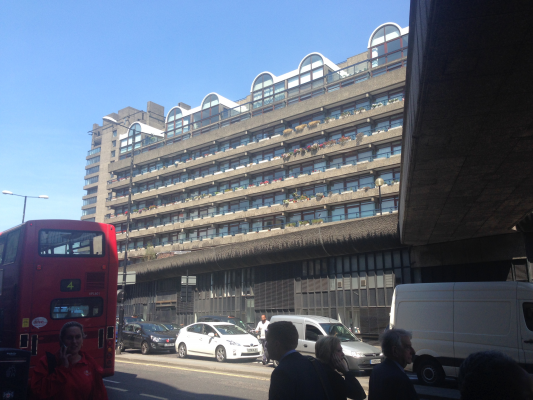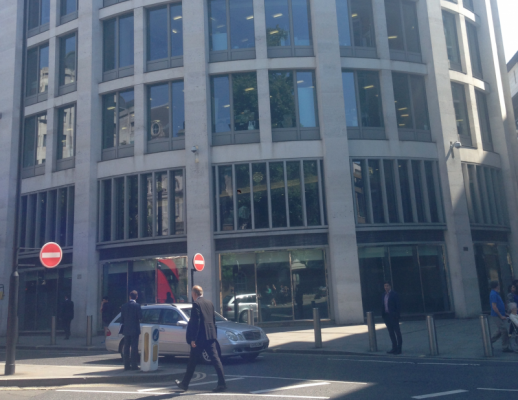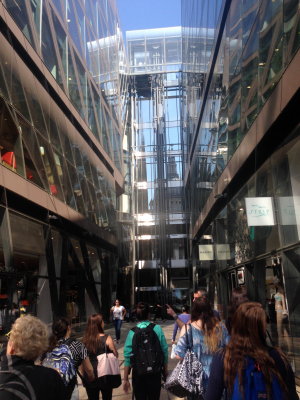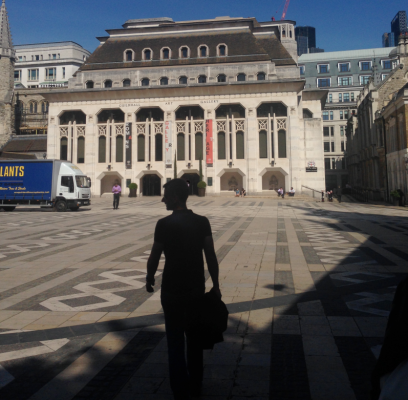A Walk Through the City of London
June 22, 2015
“You never walk on the main street unless you have to be on the main street,” instructed Sean Gallagher as he led us through one of the oldest parts of the City of London. This quote stuck with me throughout our walking tour starting at Barbican tube station. We took our first turn off the busy Aldersgate Street, lined with modern, cement high-rise buildings. Middle Street was more historic, which led us to a pub called The Hand & Sheers that was established in 1532 and a church, St. Bartholomew The Great, that is over 1000 years old. The juxtaposition of old and new in the City of London is what makes wandering through its streets so remarkable, especially if you allow yourself to get lost on the side streets.

We continued down the alleyway past the ancient church and back on to a main road, West Smithfield and came across a road called Cock Lane. Sean explained, “They say that this was where, in 1666, the Great Fire of London stopped.” Just the day before, while on a different walking tour, we learned that the five-day fire began a mile away on Pudding Lane at the bakery of Thomas Farriner. The Great Fire spread over most of the city, destroying countless churches and buildings, including St. Paul’s Cathedral and left only buildings made of stone like Guildhall. Estimates of casualties range from as little as four to as many as thousands. Christopher Wren, the architect of St. Paul’s Cathedral, constructed a monument between 1671 and 1677 to commemorate the fire and mark the rebuilding of the city.
As we turned on to another main street, St. Paul’s Churchyard, we came to the iconic St. Paul’s Cathedral. With its domed top that looms above most of the cities’ buildings, it’s a staple of historical architecture in London. What is amazing, yet typical of London, is the contrast between the street behind the 300-year-old St. Paul’s that houses the London Stock Exchange, a modern building made up entirely of cement and glass. This is exactly the type of combination of new and old that contributes to Sean’s observation that, “London is always changing. They’re very protective of old old buildings, but they tear down new old buildings to build new new buildings.”

On the street perpendicular to St. Paul’s Churchyard, we walked to One New Change, a modern skyscraper comprising major offices and the largest shopping center in the City of London. As he is a resident of this neighborhood, Sean said, “I refer to this as my mall. I come to this place on a Saturday or a Sunday when all the shops are open because I tend to use the city as my backyard.” He took us to the Madison, a rooftop bar, for a photo-op of its sweeping views of the London skyline. As I looked out across the sea of buildings, St. Paul’s Cathedral was front and center (due to its proximity to One New Change). I also saw the countless buildings that have been a part of London since it was rebuilt after the Great Fire. In contrast, newer structures like The Shard also stuck out. In fact, deep in the distance I could see at least five cranes, all in the midst of building more modern skyscrapers.

Tucked between buildings on Angel Street, we came to Postman’s Park, a peaceful sanctuary and a former burial ground from 1880. On the side of the park, a tiled wall sheltered by an overhang holds sobering words. Named The Memorial to Heroic Self Sacrifice, it contains twenty-four tablets with the names and stories of ordinary people who died saving the lives of others. While standing next to the memorial, Sean remarked, “The world can be a dark, horrible place. Except for these people who selflessly died saving others.” One tablet featured in the movie “Closer” reads, “Alice Ayres, daughter of a bricklayer’s labourer, who by intrepid conduct saved 3 children from a burning house in Union Street Borough at the cost of her own young life.”

At the end the walking tour, Sean brought us to the Roman ruins; an amphitheater that housed gladiator fights, beneath the Guildhall Art Gallery. In 55 B.C., the Romans invaded London, turning it into a major Roman commercial center. This was the perfect way to finish: bringing full circle the old and the new in London. It confirmed again that London is a mixture of historical richness and modern progression. And as long as you venture off of the main streets, you can experience all of London’s gems.
Barbican Tube Station
City of London










